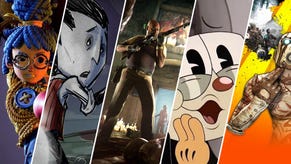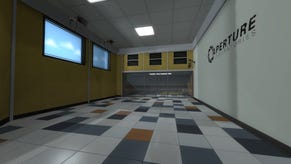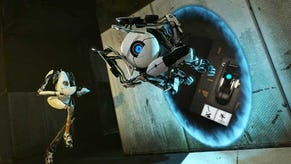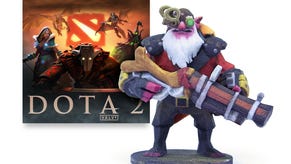Valve VR prototype is "lightyears ahead of the original Oculus Dev Kit," says dev after studio visit
Valve's VR headset device will not be sold commercially, but one developer at Iridium Studios visited the company in Seattle to try it out. In his detailed report, he claims that the peripheral is "lightyears" ahead of the original Oculus Rift device.
The reason why Valve is not selling the device, is that it is using it internally to make Steam the go-to place for VR experiences, according to Iridium developer 'Feep.'
Over on NeoGAF he said, "Steam is fully supporting VR as a standard library, and they have a vested interest in making their marketplace the “go to” place for VR experiences. A lot of their work is shared with Oculus, as well."
Then, Feep gave his full impressions on Valve's kit. "Valve’s solution is lightyears ahead of the original Oculus Dev Kit," he claimed. "Resolution, while not at 'retina' level perfection, was no longer really a significant issue. The screen door effect was almost completely negligible, thanks to a shiny 1080p display. (Not actually shiny, shiny like in Firefly.)
"Just as fantastic was their low-persistance display tech. The display ran at a blistering 95 Hz, and the pixels only flash for approximately 20% of that 10.52 ms refresh time. You don’t notice any flickering or lack of brightness, and the plus side is that ghosting and smearing were drastically reduced. Not *completely* eliminated, mind you.
"Latency? Low. Approximately 25ms. Not noticeable."
Feep added that VR's elephant in the room - motion sickness - has been countered by Valve by placing "QR code-like papers on the walls," so that the camera can see its own position at all times. Looking at the floor however, because it didn't have QR codes on it, caused the headset to lose its position.
Valve's device isn't wireless, and Feep suggested that this is perhaps due to latency concerns, before discussing the 15 tech demos he tried while at the studio. "None of them were even remotely close to a 'game,' he stressed, "and existed mostly as visual experiences."
"The first demo stuck me in a simple room, whose walls were textured with financial data for Facebook from some website. An odd choice, yeah. There was a little red cube bouncing around the room, and the desire to avoid it was *extremely strong*. A dodgeball / laser field game immediately popped into my mind, but as I mentioned before, a tether really hurts this type of idea.
"I want to point out how strong the positional tracking is, here. *I was moving around and dodging something with absolutely zero issue.* Jumping, ducking, Matrix-dodging, whatever. It’s bizarre how compelling this demo was, as it could be knocked up in Unity in approximately seven minutes."
Another demo saw Feep standing on a high ledge that led to a sheer drop. He claimed that the simulation made him reluctant to step off the side. There was also a Portal 2 demo, "one featured Atlas," he explained, "one of the co-op robots from Portal 2, in three different sizes. Directly in front was a human-sized version, then off to the right was a tiny little figure model, and then directly behind me was a five-story tall version.
"Scale is *extremely impressive* in VR, and apparently several people actually instinctively tried to get out their phones and take a picture. Heh. Not gonna work, nerds. The next was the really cool 'turret building' from Portal 2, an extremely intricate animation. It was cool to get up close and really see it from different angles.
"As cool as “big things” are in VR, though, 'small things' are equally impressive. Someone had taken the set from the Portal 2 Valentine’s Day advertisement, moving stick figures and all, and placed it down as a miniature model a la Beetlejuice in front of the player.
"Tiny desks, tiny people, tiny coffee mugs! In a normal game, you could manipulate the camera to get close enough to the tiny coffee mugs so that they appeared to be large, but that simply isn’t possible in VR: you matter how close you got, they were still little tiny coffee mugs, because your perceptions of distance and scale are accurate. It would really be an incredible sensation for any 'god game', towering over and examining your creations from a giant’s throne above. And you know what? The stick figures looked great in 3-D. Really cool."
Signing off, Feep explained that he and Valve discussed the VR concept and its future for some time, and added, "This is an incredible, potentially world-changing technology. There are obstacles to overcome, but many of them have already been conquered. The use cases for these devices are almost literally infinite. This is the future. Tron is the future."
What do you make of the above?
Via DualShockers.









